1
slow cooking
smarts
It doesn’t take a lot of cooking know-how to make a tasty slow cooker meal—that’s the beauty of a slow cooker! However, a few easy tips and some slow cooker basics will help you make a sensational meal every time.
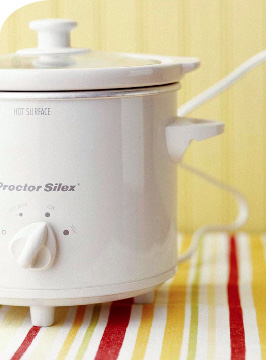
type matters
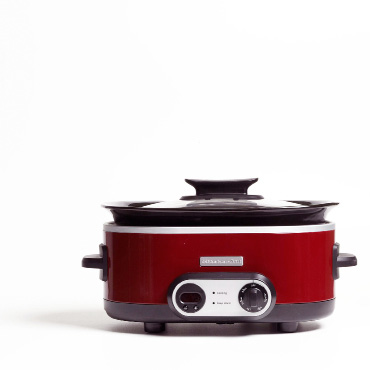
There are two basic types of slow cookers. The first type has a crockery insert and two temperature settings: low (about 200°F) and high (about 300°F). The heating coils wrap around the sides of the cooker. This allows for the continuous slow cooking needed for the recipes in this book. It cooks foods at a very low wattage. The liner may or not be removable. The second type has an adjustable thermostat indicating temperature in degrees. The heating coil is located in the bottom of the cooker—the only place heat is applied—and the element cycles on and off during cooking.
When buying a slow cooker, look for these features:
* A snug-fitting, see-through lid.
* A removable ceramic or stainless-steel insert or liner. They are easier to clean if you can take them out of the cooker. The insert should also have large, sturdy handles to make it easier (and safer) to remove it from the base. A “stove-top-safe” insert is an excellent feature for one-pan browning. Consider a stainless-steel insert if a ceramic insert feels too heavy.
* A programmable timer to set the cooker to start if you will be gone all day. (Note: The cooker should be set to start within 2 hours of filling it.) Some timers can be programmed to cook on high for a set time and then switch to low.
* Cookers with wraparound heating elements heat more evenly than those with the element on the bottom.
* Oval-shaped cookers are better suited to oblong cuts of meat and are easier to pour from than round cookers.
Cooker Size and Use
Check out this chart for guidelines on how to select the right size cooker for your recipe. All recipes in this book indicate the size of the cooker needed for the amount of ingredients called for.
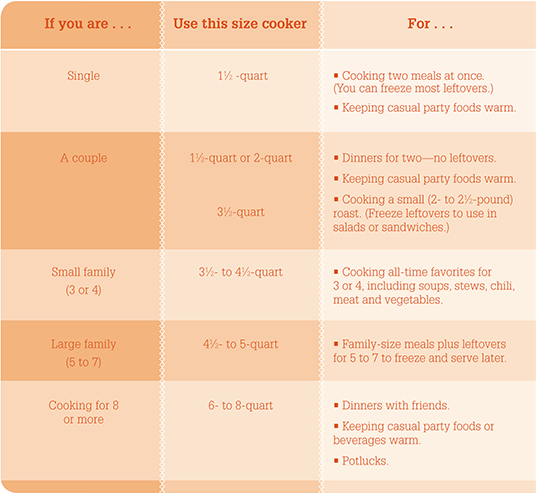
Don’t peek! (Keep a lid on it.) Lifting the lid releases valuable moisture and heat.
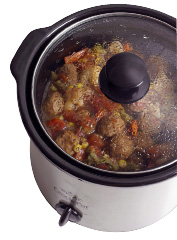
slow-cooker savvy
It’s safe to toss ingredients in a slow cooker and walk away because the long cooking time and the steam that forms in the tightly covered container destroy any bacteria. Follow the easy tips below to ensure your slow cooker meal is not only safe but delicious as well.
* Clean the cooker and all utensils before you start. Do not use the slow cooker for large pieces of meat. Cut in half any roasts larger than 21⁄2 pounds.
* Save time in the morning by preparing ingredients for tomorrow’s dinner the night before. Place chopped ingredients in tightly sealed containers (except for partially cooked meats) in your refrigerator overnight. Be sure to cover cut-up potatoes with water so they don’t discolor before cooking. It’s okay to brown ground meat and refrigerate overnight because browning fully cooks the meat. However, if your recipe calls for a roast or cubed meat for stew, brown the meat just before plugging in your slow cooker as browning doesn’t completely cook those cuts.
* Schedule your cooking by using a plug-in timer. Be sure ingredients in the cooker are well chilled, and set the timer to start within two hours. Do not use this delayed cooking method for recipes that include frozen fish or poultry.
* Add herbs at the right time to the slow cooker. Because dried herbs have more staying power, crush and add them at the beginning of cooking. Add fresh herbs just minutes before serving—except for rosemary, which can survive long hours in a cooker.
* Ensure that your slow cooker is safe if it is older or you are unsure of its heating ability. Fill it half to two-thirds with water. Heat it on the low-heat setting, covered, for 8 hours, and then check the water temperature with an accurate food thermometer. It should be about 185°F. It it’s not, it’s time to retire the cooker.
* Fill the cooker at least half full and no more than two-thirds full.
* Browning meat before adding it to the slow cooker adds extra flavor and color. If you’re in a hurry, skip the browning.
* Never toss frozen raw meat directly into your slow cooker. Bacteria grow most rapidly between 40°F and 140°F. Because the slow cooking process brings fresh or thawed meat up to temperature at a slow rate, frozen meat placed in the cooker hovers within the danger zone for far too long, putting you and others who eat it at risk.
* Allow your meals to cook as long as specified in the recipe.
* Never place a hot insert on a cool surface. Likewise, an insert that has been refrigerated should not be placed in a hot base unit. A sudden change in temperature could cause the insert to crack.
* To avoid burns from hot steam that is created on the inside of the lid during cooking, lift the lid gently and straight up without tilting.
* Leave disposable nylon liners and the cooking liquids in the slow cooker insert until they have cooled to a safe handling temperature. However, when making a bread pudding or stuffing in the slow cooker, the edges of the nylon liner can be carefully grasped to lift the pudding out of the insert (wear oven mitts) and transfer it to a cutting board. Then, just peel back or cut the liner and slice the pudding into wedges for serving.
*When you live at high altitudes. add about 30 extra minutes for each hour of cooking time called for in a slow cooking recipe. If the recipe suggests a cooking time of 5 hours, for example, cook it for 71⁄2 hours.
Add dried crushed herbs at the beginning of cooking. Fresh herbs are more delicate so add them minutes before serving.
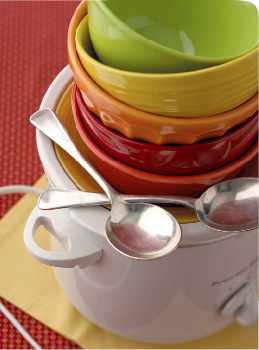
Freezer Sense
One of the great things about cooking many of the recipes in this book is that you can freeze leftovers to reheat and enjoy on another day. To successfully freeze foods and maintain good flavor, here are a few pointers.
Choose freezer-safe containers or bags. Look for moisture-proof and vapor-proof materials that can withstand temperatures of 0°F or below and can be tightly sealed. For liquid or semiliquid foods, use rigid plastic containers, bags, or wide-top jars designed for freezing. Regular jars seldom are tempered to withstand freezer temperatures.
Cool hot foods quickly. Divide soups and stews into portions that are 2 to 3 inches deep and stir while cooling. Divide roasts and whole poultry into portions that are 2 to 3 inches thick. Place the food in the refrigerator. When thoroughly chilled, transfer food to freezer containers. Arrange containers in a single layer in the freezer to allow cold air to circulate around them. Once the food is frozen, stack the containers for storage.
Remove excess air. This will help prevent freezer burn. There is an exception: When freezing cooked food, you’ll want to leave about 1⁄2 inch of space between the top of the food and the rim of its container. This will provide room for the food to expand while it freezes without breaking the container or causing the lid to pop off.
Be label conscious. Include the name of the recipe, the quantity, the date it was frozen, and the number of servings.
Maximum Freeze Times
Roasts and Meat Dishes (Cooked): 3 months
Poultry Dishes (Cooked): 4 months
Soups and Stews: 6 months
toting foods safely
Don’t risk ruining a wonderful potluck or family gathering by ignoring some basic food safety. Here are some tips to keep in mind.
* Plan to have your food finish cooking just as you’re ready to leave home.
* Wrap the covered slow cooker in several layers of newspaper or a heavy towel. Place in an insulated cooler for transport. The food should stay hot for up to 2 hours. If you are using an electric slow cooker, plug it in when you arrive at your destination and the food will keep warm on the low-heat setting for hours.
* Use your cooker to transport. Depending on the type of food you are toting, the slow cooker is a perfect transporter for soups, stews, and some casseroles. Again, plug the cooker in as soon as you arrive at your destination.
Cleaning Your Slow Cooker
To keep your slow cooker working properly, follow a few guidelines when cleaning it.
*Unplug the slow cooker and fill the liner with hot soapy water (do not add cold water when the crockery liner is hot) as soon as your remove the food from the cooker. Let the liner soak while you’re eating. Never immerse the cooker or cord in water.
*Be careful during cleaning not to hit the crockery liner on the faucets or hard surfaces of your sink. Crockery chips easily.
*If soaking does not remove all the food residue, use a sponge, cloth, plastic cleaning pad, or nonabrasive cleaner to clean the crockery liner.
*If your cooker has a removable crockery liner, wash it, after soaking, in a dishwasher or by hand.
*For a cooker with a nonremovable crockery liner, wipe the liner clean with a dishcloth and soapy water after soaking. Rinse carefully and wipe dry.
*Both glass and plastic cooker lids are dishwasher safe, but be sure to put plastic lids only on the top rack of your dishwasher.
*Wipe the outside of the cooker’s metal shell with a damp soft cloth and dry it with a towel.
crockery conversions
With a little tweaking, you can cook many of your favorite conventional soups, stews, and roasts in your slow cooker.
 Choosing a recipe: Use recipes that call for less tender cuts of meat, such as beef chuck roast, beef brisket, pork shoulder, and stew meat. Use a sample recipe as a guide to estimate ingredient quantities and timings.
Choosing a recipe: Use recipes that call for less tender cuts of meat, such as beef chuck roast, beef brisket, pork shoulder, and stew meat. Use a sample recipe as a guide to estimate ingredient quantities and timings.
 Quantities: The slow cooker must be at least half full and no more than two-thirds full. If necessary, add an extra potato, carrot, or onion to fill the cooker to the halfway point.
Quantities: The slow cooker must be at least half full and no more than two-thirds full. If necessary, add an extra potato, carrot, or onion to fill the cooker to the halfway point.
 Vegetables: Cut potatoes, carrots, parsnips, and other dense vegetables into bite-size pieces; place them in the bottom of the cooker. Add tender vegetables, such as fresh or frozen broccoli, green beans, or peas, at the end of the cooking time and cook on the high-heat setting for 30 minutes or until tender.
Vegetables: Cut potatoes, carrots, parsnips, and other dense vegetables into bite-size pieces; place them in the bottom of the cooker. Add tender vegetables, such as fresh or frozen broccoli, green beans, or peas, at the end of the cooking time and cook on the high-heat setting for 30 minutes or until tender.
 Meat: Trim any fat from the meat and cut roasts larger than 21⁄2 pounds in half. If desired, brown the meat. Place the meat on top of the vegetables.
Meat: Trim any fat from the meat and cut roasts larger than 21⁄2 pounds in half. If desired, brown the meat. Place the meat on top of the vegetables.
 Poultry: Remove skin from poultry pieces before cooking.
Poultry: Remove skin from poultry pieces before cooking.
 Ground meats, poultry, and sausage: Brown all ground meats, poultry, and sausage in a skillet over medium heat. These products must be completely cooked before you place them in the slow cooker.
Ground meats, poultry, and sausage: Brown all ground meats, poultry, and sausage in a skillet over medium heat. These products must be completely cooked before you place them in the slow cooker.
 Liquids: Reduce by about half the total amount of the liquid in your recipe.
Liquids: Reduce by about half the total amount of the liquid in your recipe.
 Thickeners: Use quick-cooking tapioca for thickening stews and sauces, or thicken the juices with cornstarch and flour in a saucepan at the end of cooking. For each cup of liquid, use 1 tablespoon cornstarch or 2 tablespoons all-purpose flour. Quick-cooking tapioca (crushed) is most often added to a recipe in the beginning because it doesn’t break down during the long cooking time.
Thickeners: Use quick-cooking tapioca for thickening stews and sauces, or thicken the juices with cornstarch and flour in a saucepan at the end of cooking. For each cup of liquid, use 1 tablespoon cornstarch or 2 tablespoons all-purpose flour. Quick-cooking tapioca (crushed) is most often added to a recipe in the beginning because it doesn’t break down during the long cooking time.
 Dairy products: Milk, cream, and natural cheeses break down when cooked for long periods of time; stir them in near the end of cooking time. Canned condensed cream soups and packaged white sauce mixeswork well to add creaminess to your recipe. Evaporated milk also can be used if you add it during the last 30 to 60 minutes of cooking time.
Dairy products: Milk, cream, and natural cheeses break down when cooked for long periods of time; stir them in near the end of cooking time. Canned condensed cream soups and packaged white sauce mixeswork well to add creaminess to your recipe. Evaporated milk also can be used if you add it during the last 30 to 60 minutes of cooking time.
 Dried beans: Rinse beans and place in saucepan. Add enough water to cover beans by 2 inches. Bring to boiling; reduce heat. Simmer, uncovered, for 10 minutes. Remove from heat. Cover and let stand for about 1 hour. Drain and rinse beans before adding them to slow cooker.
Dried beans: Rinse beans and place in saucepan. Add enough water to cover beans by 2 inches. Bring to boiling; reduce heat. Simmer, uncovered, for 10 minutes. Remove from heat. Cover and let stand for about 1 hour. Drain and rinse beans before adding them to slow cooker.